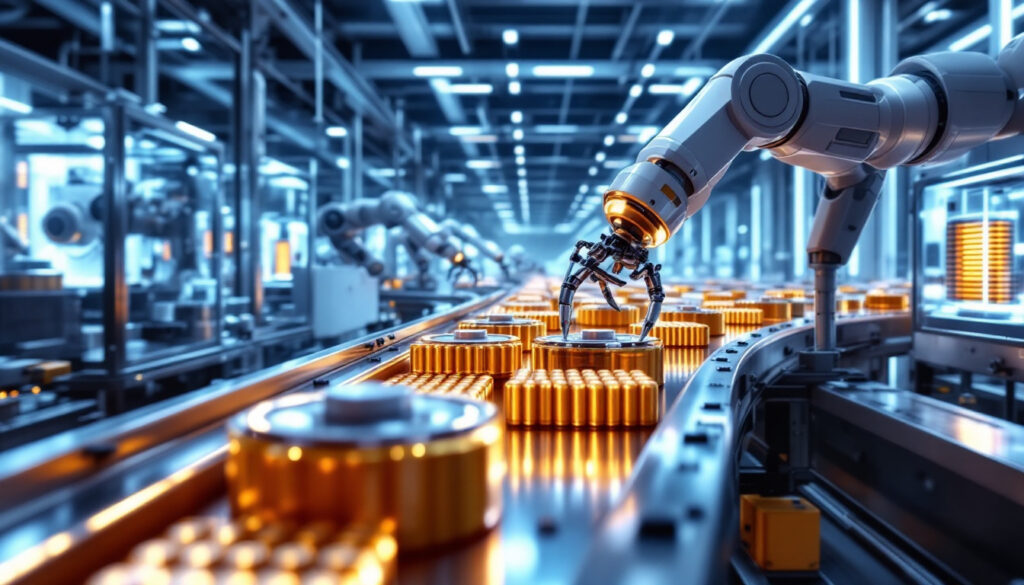The Strategic Partnership Between LEAD and FAAM
The Groundbreaking 8 GWh LFP Factory Project
LEAD, a Chinese mechanical engineering company, has secured a significant contract with FAAM, an Italian battery manufacturer, to supply advanced end-of-line systems for the Teverola 2 factory near Naples. This collaboration marks a major milestone in European battery manufacturing, with the facility designed to achieve 8 GWh production capacity of LFP (Lithium Iron Phosphate) batteries.
The partnership represents a strategic East-West technology transfer, combining Chinese engineering expertise with European manufacturing ambitions. Once fully operational in 2027, the factory will have capacity to power approximately 100,000-160,000 electric vehicles annually, depending on battery size configurations.
"This collaboration demonstrates how international partnerships can accelerate Europe's battery manufacturing capabilities," notes industry analyst Maria Carvallo. "The knowledge transfer happening through these projects is compressing learning curves that would typically take 5-7 years into just 2-3 years."
Key Components of the Supply Agreement
The contract between LEAD and FAAM specifically focuses on end-of-line (EOL) systems, which manage critical final production stages including electrolyte filling, cell formation (first charging cycle), and comprehensive quality inspection. These systems represent some of the most technically sophisticated aspects of battery manufacturing.
Industry data suggests that properly executed EOL processes can increase cell capacity by 5-10% and extend cycle life by up to 20% compared to suboptimal formation protocols. This performance enhancement translates directly to competitive advantage in the rapidly evolving battery metals boom.
The agreement highlights a growing trend of European manufacturers seeking specialized expertise from established Asian producers to build domestic battery production capabilities. By partnering with LEAD, FAAM gains access to proprietary technologies that have been refined through years of implementation in high-volume Chinese factories.
Why Are End-of-Line Systems Critical in Battery Manufacturing?
The Technical Significance of EOL Processes
End-of-line processes establish the fundamental electrochemical properties of each battery cell. During electrolyte filling, precisely measured amounts of specialized electrolyte solutions are introduced into each cell under strictly controlled conditions. This process directly impacts ion mobility, internal resistance, and overall performance characteristics.
The formation cycling (initial charge-discharge sequences) creates the critical solid electrolyte interphase (SEI) layer that protects the anode from unwanted side reactions while allowing lithium ions to pass freely. This microscopic boundary layer, only nanometers thick, largely determines the battery's long-term stability and safety profile.
Key formation parameters that impact battery performance include:
- Charge-discharge current rates (C-rates)
- Temperature profiles during cycling
- Rest periods between cycles
- Upper and lower voltage cutoffs
- Transition timing between constant current and constant voltage phases
These variables must be precisely controlled to optimize battery performance, with small deviations potentially causing significant impacts on capacity, cycle life, and safety characteristics.
Quality Control and Safety Implications
The EOL systems supplied by LEAD incorporate advanced testing and inspection technologies that identify potential defects before batteries leave the factory. This quality assurance capability is particularly important for European manufacturers competing with established Asian producers.
Multiple inspection points throughout the process can reduce defect rates to below 10 parts per million (PPM), meeting stringent automotive-grade quality requirements. Testing protocols include:
- Visual inspection using AI-enhanced imaging systems
- Electrical performance verification (capacity, internal resistance)
- Thermal behavior monitoring
- Gas detection for early warning of chemical irregularities
- Multi-point dimensional verification
For FAAM, these quality control capabilities represent a significant competitive advantage as European manufacturers work to establish reputation for reliability comparable to established Asian producers.
What Technological Innovations Are Being Implemented?
Advanced Energy-Efficient Charging Technologies
LEAD's system features proprietary charging and discharging technologies specifically designed to reduce energy consumption during the formation phase. Industry data suggests that formation typically accounts for 30-40% of the energy used in cell manufacturing. The new technologies could potentially reduce this energy requirement by 15-25%, representing significant cost savings at scale.
The system implements adaptive charging algorithms that continuously optimize current and voltage parameters based on real-time cell performance feedback. This dynamic approach reduces energy waste while improving formation effectiveness compared to static protocols commonly used in conventional systems.
"Energy optimization during formation is increasingly critical as manufacturers scale production," explains battery engineer David Kang. "A 20% reduction in formation energy consumption can translate to millions in savings annually at gigafactory scale, while simultaneously reducing carbon footprint."
Negative Pressure Tray Formation Innovation
One of the most significant innovations in the partnership is LEAD's "negative pressure tray formation technology." This breakthrough approach reduces cleanroom space requirements by up to 90% compared to conventional methods.
Traditional formation processes typically require entire rooms maintained as cleanroom environments, with comprehensive air handling systems and specialized infrastructure. LEAD's approach creates localized controlled environments around each formation tray rather than requiring entire rooms to maintain cleanroom conditions.
The technology uses a sealed tray design with negative pressure zones that prevent contaminants from entering the cell environment. This approach allows for:
- Dramatic reduction in cleanroom footprint (up to 90% space savings)
- Lower HVAC energy consumption
- Reduced cleanroom construction costs
- More flexible factory layout options
- Easier maintenance access to equipment
These advantages significantly reduce both capital expenditure during factory construction and ongoing operational costs throughout the production lifecycle.
Thermal Management Advancements
The collaboration introduces intelligent thermal management systems that maintain precise temperature control for each battery cell throughout the formation process. Temperature variations of even 2-3°C during formation can significantly impact cell performance uniformity.
LEAD's system reportedly maintains temperature consistency within ±0.5°C, ensuring exceptional quality control. This precision is achieved through:
- Liquid cooling channels integrated into formation trays
- Individual cell temperature monitoring
- Adaptive cooling/heating adjustments based on real-time measurements
- Thermal isolation between cell groups to prevent cascade effects
- AI-driven predictive temperature management
This precise thermal management directly translates to more consistent cell performance characteristics, reducing the performance variability that can complicate battery pack design and management.
What Economic Benefits Does This Partnership Deliver?
Operational Cost Reduction Strategies
The partnership aims to reduce operational costs through multiple mechanisms:
- Energy efficiency improvements: 15-25% lower energy consumption during formation processes
- Space utilization optimization: Up to 90% reduction in cleanroom space requirements
- Yield rate improvements: Enhanced process control leading to fewer rejected cells
- Accelerated throughput: Optimized formation protocols requiring less time per cell
- Reduced labor requirements: Higher automation levels requiring fewer operators per GWh
When combined, these improvements position FAAM to achieve production costs more aligned with established Asian manufacturers, which typically operate 10-15% below current European cost structures.
The energy savings are particularly significant in the European context, where industrial electricity prices are approximately 2-3 times higher than in many Asian manufacturing regions. By reducing formation energy requirements, FAAM can partially offset this regional disadvantage.
Competitive Positioning in the European Battery Market
The collaboration positions FAAM to compete more effectively in the European battery market, which is projected to reach €250 billion by 2030. By implementing advanced lithium processing technologies, FAAM can potentially achieve production costs closer to those of established Asian manufacturers.
This competitive positioning is particularly important as European automotive manufacturers increasingly prioritize regional supply chains to:
- Reduce logistics complexities and costs
- Minimize supply chain disruptions
- Meet localization requirements for EV incentives
- Reduce carbon footprint of battery procurement
- Align with EU industrial strategy objectives
The 8 GWh capacity represents enough batteries for approximately 100,000-160,000 electric vehicles annually, establishing FAAM as a significant player in the European battery ecosystem.
How Does This Fit Into the Broader Battery Manufacturing Ecosystem?
Complementary Technology Integration
The LEAD and FAAM battery factory collaboration is part of a broader technology integration strategy at the Teverola 2 facility. In addition to LEAD's EOL systems, FAAM has contracted with Swiss technology group Bühler for four continuous mixing lines for electrode paste production.
This multi-vendor approach combines specialized expertise from global leaders in different aspects of battery manufacturing:
- Bühler: Specializing in precise material mixing and processing
- LEAD: Focusing on EOL systems and formation technologies
- FAAM: Contributing battery design and integration expertise
The integration of these complementary technologies requires sophisticated interface management and standardized communication protocols to ensure seamless operation between systems from different vendors.
Timeline and Production Roadmap
The implementation timeline reveals a strategic approach to factory commissioning:
- End of 2025: Installation of Bühler mixing systems
- Early 2026: Integration of LEAD EOL systems
- Mid-2026: Projected start of commercial production
- 2027: Expected ramp to full 8 GWh capacity
This phased approach allows for sequential optimization of each production step before moving to full-scale operations. Industry experience suggests that such careful commissioning typically yields higher long-term performance than rushed implementation schedules.
The timeline aligns with projected European battery demand growth, which is expected to accelerate significantly between 2025-2030 as automotive manufacturers increase EV production volumes to meet regulatory requirements.
What Are the Implications for European Battery Manufacturing?
Technology Transfer and Knowledge Development
This collaboration represents a significant example of technology transfer from China to Europe in the battery sector. While European manufacturers have traditionally relied on Asian expertise, partnerships like this contribute to building local knowledge and capabilities.
Industry analysts suggest such collaborations could accelerate Europe's battery manufacturing learning curve by 2-3 years. This acceleration is vital for European competitiveness, as Asian manufacturers currently benefit from 5-10 years of high-volume production experience.
The knowledge transfer extends beyond equipment operation to include:
- Process optimization techniques
- Quality control methodologies
- Maintenance and troubleshooting expertise
- Supply chain management strategies
- Production scaling methodologies
This comprehensive knowledge development strengthens Europe's overall battery manufacturing ecosystem, potentially benefiting other regional manufacturers through workforce mobility and supplier capability enhancement.
Supply Chain Resilience and Regional Production
The establishment of advanced manufacturing capabilities in Italy strengthens European battery supply chain resilience. With an 8 GWh capacity, the Teverola 2 factory could supply batteries for approximately 100,000-160,000 electric vehicles annually, reducing dependency on imported cells.
This localization aligns with the European Battery Alliance objectives of establishing 400-750 GWh of European battery production capacity by 2030. Regional production offers several strategic advantages:
- Reduced logistics complexity and costs
- Shorter lead times for automotive manufacturers
- Decreased exposure to international shipping disruptions
- Lower transportation-related carbon emissions
- Enhanced alignment with circular economy initiatives
The focus on LFP chemistry also represents a strategic diversification, as European production has historically emphasized NMC (Nickel Manganese Cobalt) chemistries. LFP offers advantages in cost, safety, and raw material availability that make it increasingly attractive for certain applications, especially considering recent lithium export controls from some countries.
How Do These Technologies Compare to Industry Standards?
Benchmarking Against Current Production Methods
When compared to industry standards, LEAD's EOL systems offer several advantages:
| Feature | Traditional EOL Systems | LEAD's Advanced EOL Systems | Advantage |
|---|---|---|---|
| Cleanroom Requirements | Full room environment | Negative pressure tray technology | 90% space reduction |
| Energy Consumption | Standard formation protocols | Advanced charging/discharging technologies | 15-25% energy savings |
| Temperature Control | ±2°C variation typical | ±0.5°C precision control | Better cell uniformity |
| Process Monitoring | Batch-level monitoring | Cell-level monitoring and control | Higher quality assurance |
| Chemistry Flexibility | Often chemistry-specific | Adaptable to multiple chemistries | Future-proofing |
| Integration Capability | Limited connectivity | Advanced data exchange protocols | Better factory optimization |
These performance advantages position the Teverola 2 facility to achieve quality and efficiency metrics comparable to leading Asian manufacturers, despite Europe's relatively limited experience in high-volume battery production.
Future-Proofing Manufacturing Capabilities
The technologies being implemented at Teverola 2 incorporate flexibility for future battery chemistry adaptations. While initially focused on LFP production, the systems can reportedly be reconfigured for other chemistries with minimal modifications, providing strategic adaptability as battery technologies evolve.
This flexibility is particularly valuable given the rapid pace of battery technology development. Systems designed for a single chemistry often become obsolete as new formulations emerge, but LEAD's modular approach allows for:
- Adaptation to emerging cathode chemistries
- Accommodation of silicon-enhanced anodes
- Support for higher nickel-content cathodes
- Potential compatibility with solid-state electrolytes
- Adjustment for larger format cells
This adaptability extends the effective lifespan of capital investments, improving long-term return on investment and reducing technology obsolescence risks.
What Challenges Must Be Overcome for Successful Implementation?
Technical Integration Complexities
Integrating advanced systems from multiple international vendors presents significant technical challenges. Compatibility between LEAD's EOL systems and Bühler's mixing lines requires careful interface management and standardized communication protocols.
Industry experience suggests that such integration typically requires 3-6 months of optimization after initial installation. Common challenges include:
- Data format standardization between systems
- Synchronized production pacing
- Quality control parameter alignment
- Consistent material handling between process steps
- Unified monitoring and control systems
Successful navigation of these complexities requires cross-functional teams with expertise spanning mechanical engineering, chemical processing, software integration, and production management.
Workforce Development and Knowledge Transfer
Successfully operating advanced battery manufacturing equipment requires specialized knowledge. The partnership will likely include comprehensive training programs for FAAM's workforce, with technical specialists from LEAD providing on-site support during commissioning and initial operations.
Workforce development requirements typically include:
- Technical training on equipment operation and maintenance
- Process optimization methodologies
- Quality control procedures and standards
- Troubleshooting and problem-solving approaches
- Advanced process monitoring and data analysis
This knowledge transfer is essential for long-term operational success, as continued reliance on external expertise would limit operational flexibility and increase ongoing costs.
Disclaimer: The timeline and production estimates mentioned in this article are based on current projections and industry analysis. Actual implementation schedules and production capacities may vary based on market conditions, supply chain factors, and technological developments.
LEAD and FAAM's battery factory collaboration represents a significant advancement in European battery manufacturing capabilities, combining Chinese technological expertise with European production infrastructure. By implementing direct lithium extraction and other innovative lithium strategy approaches, the partnership aims to enhance production efficiency, reduce operational costs, and strengthen Europe's position in the global battery market.
Looking to Invest in Battery Manufacturing and Lithium Technology Companies?
Discover high-potential ASX stocks in the booming battery materials sector with Discovery Alert's proprietary Discovery IQ model, which provides instant notifications on significant mineral discoveries that could deliver substantial returns. Explore historic examples of exceptional investment outcomes on the Discovery Alert's discoveries page and position yourself ahead of the market.




